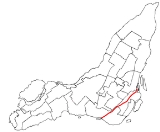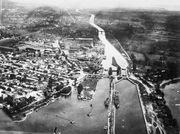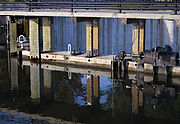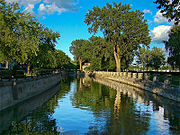
Lachine Canal
Encyclopedia
The Lachine Canal is a canal
passing through the southwestern part of the Island of Montreal
, Quebec
, Canada
, running 14.5 kilometres from the Old Port of Montreal
to Lake Saint-Louis
, through the boroughs of Lachine, Lasalle and Sud-Ouest
.
The canal gets its name from the French word for China (La Chine). The European explorers dreamt of finding a route from New France to the Western Sea and there on to China and hence auspiciously the region where the canal was built was named Lachine.
 The canal is situated on land originally granted by the King of France to the Sulpician Order. Beginning in 1689, attempts were made by the French Colonial government
The canal is situated on land originally granted by the King of France to the Sulpician Order. Beginning in 1689, attempts were made by the French Colonial government
and several other groups to build a canal that would allow ships to bypass the treacherous Lachine Rapids
. After more than 130 years of failure, a consortium that included the young Scottish
immigrant John Redpath
was successful. John Richardson
was Chairman of the Committee of Management of the canal project and its chief engineer was Thomas Brunett. The contractors were Thomas McKay
and John Redpath
, plus the firms of Thomas Phillips & Andrew White
and Abner Bagg & Oliver Wait.
Work on the canal commenced on July 17, 1821 under Chief Engineer Thomas Burnett and Construction Engineer John Richardson. The original canal was 14 km. long and had seven locks, each 30 m long, 6m wide and 1.5 m deep. The Lachine Canal which was inaugurated in 1824 and opened to navigation in 1825.
The new canal officially opened in 1825, helping turn Montreal
into a major port and eventually attracting industry to its banks when the Society of Sulpician Order
decided to sell lots.
During the 1840s, the Lachine Canal was deepened to allow heavier ships to pass through and hydraulic power was introduced to the industries located on its banks. Through the enlargement of the canal, its use changed from solely a means of avoiding the Lachine rapids to that of an industrial region within Montreal. There were two major effects on the development of Montreal due to the enlargement of the Lachine Canal. The first was that by creating a route that bypassed the Lachine rapids and therefore opened the upper St Lawrence River to navigation, Montreal became a more convenient area for trade, effectively taking away shipping traffic from Quebec City and moving it to Montreal. The second important shift that can be noted through the growth and development of the canal is the creation of industrial suburbs. Before the Lachine Canal, Montreal’s industrial region was located in what would be considered the downtown area.
The impact of the Lachine Canal on Montreal during the mid to late 19th century can be seen through the emergence of new working class neighbourhoods such as Griffintown, St Henri, Pointe St Charles. Furthermore, the population of Montreal grew by over four times between the middle of the 19th century and the beginning of the 20th century.
One of the main reasons behind the growth of the Lachine Canal region was the access to hydraulic power which was provided through the deepening of canal in the 1840s. Throughout the mid to late 19th century, industries all along the banks of canal experienced consistent growth through the access to this energy source. However, by the end of the 19th century, factories began to utilize steam powered factories as opposed to hydraulic power. Although this switch did not initially affect the Lachine canal region in a negative manner, factories were no longer dependent on the canal as an energy source. Industries now had the option of building further and further away from the canal itself, which was also helped by the development of a railway system throughout Montreal’s industrial region.
However, while the Lachine Canal proved an enormous boom for Montreal and the Province of Quebec, time would show that for Canada's Maritime Provinces, it was the first major nail in that region's economic coffin.
The first enlargements took place between 1843 and 1848, under the supervision of Alfred Barrett
. Five new locks, each 61 m long, 13.5 m wide and 2.7 m deep replaced the original seven locks. A second enlargement of the canal took place between 1873 and 1885 at which time the locks were lengthened to 82 m and deepened to 4.3 m.
The canal continued to operate successfully until around 1950, but now, surrounded by the industrial developments which it helped to create, it could not be expanded further to cope with the continuing increase in vessel size. The canal became obsolete in the second half of the 20th century, being replaced by the St. Lawrence Seaway, which opened in 1959. The canal was finally closed to shipping in 1970. The opening of the Seaway and the decline of shipping on the canal led to the devastation of the neighbourhoods that lined the canal in Montreal's Le Sud-Ouest
borough due to shifting patterns of industrial development and shipping.
 Since 1848, the canal has had 5 locks: Lachine, Côte-Saint-Paul, Saint-Gabriel and 2 locks at Old Port of Montreal
Since 1848, the canal has had 5 locks: Lachine, Côte-Saint-Paul, Saint-Gabriel and 2 locks at Old Port of Montreal
. But initially it had seven locks:
is located near the western end of the canal.
in Lachine, Quebec
. The centre features exhibits about the building and widening of the canal, and offers information about the canal and guided tours. There is also a gift shop, lookout terraces, and an outdoor interpretation trail. The centre is open seasonally.


 At its zenith from 1880 to 1940, the industrial and manufacturing area adjacent to the canal was once the largest in Canada in terms of both the number of firms and diversity of its output. At one time, over 20% of the workforce of the Island of Montreal
At its zenith from 1880 to 1940, the industrial and manufacturing area adjacent to the canal was once the largest in Canada in terms of both the number of firms and diversity of its output. At one time, over 20% of the workforce of the Island of Montreal
was employed in its factories. Given its historic importance, the "Lachine Canal Manufacturing Complex" was designated a National Historic Site of Canada in 1996, in addition to the designation already enjoyed by the canal itself.
Over the last two decades, the canal has seen a large increase in residential and commercial development. In what was originally a very heavy industrial neighbourhood, Pointe-Saint-Charles
and Saint-Henri
have become very up and coming districts. House values have sky rocketed and many real estate developers have turned the century old industrial factories and warehouses, like that of Dominion Textiles (5524 Saint-Patrick, now Complexe Dompark) & Simmons Bedding Company
(4710 St-Ambroise, now Complexe Canal Lachine) into prestigious loft buildings. Complexe Dompark recently celebrated its 100th anniversary and now houses more than 90 multimedia, fashion, publishing, and service industry-based companies in custom designed lofts. The area around the Atwater Market has become one of Montreal's most desirable residential areas for condo owners. Much of this is thanks to the continued effort to clean up the Canal.
The old Redpath Sugar
refinery at St-Patrick and Montmorency is now partially Lofts Redpath, converted after being abandoned since 1980.
offers guided tours of the canal by foot, bicycle, and boat during the summer months.
Canal
Canals are man-made channels for water. There are two types of canal:#Waterways: navigable transportation canals used for carrying ships and boats shipping goods and conveying people, further subdivided into two kinds:...
passing through the southwestern part of the Island of Montreal
Island of Montreal
The Island of Montreal , in extreme southwestern Quebec, Canada, is located at the confluence of the Saint Lawrence and Ottawa Rivers. It is separated from Île Jésus by the Rivière des Prairies....
, Quebec
Quebec
Quebec or is a province in east-central Canada. It is the only Canadian province with a predominantly French-speaking population and the only one whose sole official language is French at the provincial level....
, Canada
Canada
Canada is a North American country consisting of ten provinces and three territories. Located in the northern part of the continent, it extends from the Atlantic Ocean in the east to the Pacific Ocean in the west, and northward into the Arctic Ocean...
, running 14.5 kilometres from the Old Port of Montreal
Old Port of Montreal
Stretching for over two kilometres along the St-Lawrence River in Old Montreal, the Old Port Of Montreal has been the social, economic and cultural soul of Montreal ever since early French fur traders used it as a trading post in 1611...
to Lake Saint-Louis
Lake Saint-Louis
Lake Saint-Louis, or in French , is a lake in extreme southwestern Quebec, Canada, adjoining the Island of Montreal at the confluence of the Saint Lawrence and Ottawa Rivers.The lake is bounded to the north and east by the Island of Montreal...
, through the boroughs of Lachine, Lasalle and Sud-Ouest
Sud-Ouest
-Places:* Sud-Ouest Region , the Burkina Faso region* Sud-Ouest Region , the Cameroon region* Ile du Sud-Ouest, an isle in the Cosmoledo atoll* Le Sud-Ouest, a borough in Montreal, Quebec...
.
The canal gets its name from the French word for China (La Chine). The European explorers dreamt of finding a route from New France to the Western Sea and there on to China and hence auspiciously the region where the canal was built was named Lachine.
History

French colonial empire
The French colonial empire was the set of territories outside Europe that were under French rule primarily from the 17th century to the late 1960s. In the 19th and 20th centuries, the colonial empire of France was the second-largest in the world behind the British Empire. The French colonial empire...
and several other groups to build a canal that would allow ships to bypass the treacherous Lachine Rapids
Lachine Rapids
The Lachine Rapids are a series of rapids on the Saint Lawrence River, between the Island of Montreal and the south shore. They are located near the former city of Lachine....
. After more than 130 years of failure, a consortium that included the young Scottish
Scotland
Scotland is a country that is part of the United Kingdom. Occupying the northern third of the island of Great Britain, it shares a border with England to the south and is bounded by the North Sea to the east, the Atlantic Ocean to the north and west, and the North Channel and Irish Sea to the...
immigrant John Redpath
John Redpath
John Redpath was a Scots-Quebecer businessman and philanthropist who helped pioneer the industrial movement that made Montreal, Quebec the largest and most prosperous city in Canada....
was successful. John Richardson
John Richardson (businessman)
John Richardson, , was born in Scotland, the son of Thomas Richardson, merchant in Portsoy and his first wife Helen Stewart of Towiemore and by 1774 was working for Phyn & Ellice, a Scottish fur trading company out of Schenectady, New York...
was Chairman of the Committee of Management of the canal project and its chief engineer was Thomas Brunett. The contractors were Thomas McKay
Thomas McKay
Thomas McKay was a Canadian businessman who was one of the founders of the city of Ottawa, Ontario. He was born in Perth, Scotland and became a skilled stonemason...
and John Redpath
John Redpath
John Redpath was a Scots-Quebecer businessman and philanthropist who helped pioneer the industrial movement that made Montreal, Quebec the largest and most prosperous city in Canada....
, plus the firms of Thomas Phillips & Andrew White
Andrew White
Andrew White may refer to:*Andrew Dickson White, American diplomat, author and educator*Andrew G. White, Australian scientist and educator*Andrew White , Anglican minister known as the 'vicar of Baghdad'*Andrew White...
and Abner Bagg & Oliver Wait.
Work on the canal commenced on July 17, 1821 under Chief Engineer Thomas Burnett and Construction Engineer John Richardson. The original canal was 14 km. long and had seven locks, each 30 m long, 6m wide and 1.5 m deep. The Lachine Canal which was inaugurated in 1824 and opened to navigation in 1825.
The new canal officially opened in 1825, helping turn Montreal
Montreal
Montreal is a city in Canada. It is the largest city in the province of Quebec, the second-largest city in Canada and the seventh largest in North America...
into a major port and eventually attracting industry to its banks when the Society of Sulpician Order
Society of Saint-Sulpice
The Society of Saint-Sulpice is a Catholic Society of Apostolic Life named for Eglise Saint-Sulpice, Paris, in turn named for St. Sulpitius the Pious. Typically, priests become members of the Society of St. Sulpice only after ordination and some years of pastoral work. Uniquely, Sulpicians retain...
decided to sell lots.
During the 1840s, the Lachine Canal was deepened to allow heavier ships to pass through and hydraulic power was introduced to the industries located on its banks. Through the enlargement of the canal, its use changed from solely a means of avoiding the Lachine rapids to that of an industrial region within Montreal. There were two major effects on the development of Montreal due to the enlargement of the Lachine Canal. The first was that by creating a route that bypassed the Lachine rapids and therefore opened the upper St Lawrence River to navigation, Montreal became a more convenient area for trade, effectively taking away shipping traffic from Quebec City and moving it to Montreal. The second important shift that can be noted through the growth and development of the canal is the creation of industrial suburbs. Before the Lachine Canal, Montreal’s industrial region was located in what would be considered the downtown area.
The impact of the Lachine Canal on Montreal during the mid to late 19th century can be seen through the emergence of new working class neighbourhoods such as Griffintown, St Henri, Pointe St Charles. Furthermore, the population of Montreal grew by over four times between the middle of the 19th century and the beginning of the 20th century.
One of the main reasons behind the growth of the Lachine Canal region was the access to hydraulic power which was provided through the deepening of canal in the 1840s. Throughout the mid to late 19th century, industries all along the banks of canal experienced consistent growth through the access to this energy source. However, by the end of the 19th century, factories began to utilize steam powered factories as opposed to hydraulic power. Although this switch did not initially affect the Lachine canal region in a negative manner, factories were no longer dependent on the canal as an energy source. Industries now had the option of building further and further away from the canal itself, which was also helped by the development of a railway system throughout Montreal’s industrial region.
However, while the Lachine Canal proved an enormous boom for Montreal and the Province of Quebec, time would show that for Canada's Maritime Provinces, it was the first major nail in that region's economic coffin.
The first enlargements took place between 1843 and 1848, under the supervision of Alfred Barrett
Alfred Barrett
Alfred Barrett was born in New England. He was an engineer by training.In about 1818, Barrett began working on the engineering staff that was constructing the Erie Canal in New York State. He rapidly gained experience and was an accredited engineer by 1821...
. Five new locks, each 61 m long, 13.5 m wide and 2.7 m deep replaced the original seven locks. A second enlargement of the canal took place between 1873 and 1885 at which time the locks were lengthened to 82 m and deepened to 4.3 m.
The canal continued to operate successfully until around 1950, but now, surrounded by the industrial developments which it helped to create, it could not be expanded further to cope with the continuing increase in vessel size. The canal became obsolete in the second half of the 20th century, being replaced by the St. Lawrence Seaway, which opened in 1959. The canal was finally closed to shipping in 1970. The opening of the Seaway and the decline of shipping on the canal led to the devastation of the neighbourhoods that lined the canal in Montreal's Le Sud-Ouest
Le Sud-Ouest
Le Sud-Ouest is a borough of the city of Montreal, Quebec, Canada.-Geography:Le Sud-Ouest is an amalgam of several neighbourhoods with highly distinct histories and identities, mainly with working-class and industrial origins, grouped around the Lachine Canal...
borough due to shifting patterns of industrial development and shipping.
Locks

Old Port of Montreal
Stretching for over two kilometres along the St-Lawrence River in Old Montreal, the Old Port Of Montreal has been the social, economic and cultural soul of Montreal ever since early French fur traders used it as a trading post in 1611...
. But initially it had seven locks:
- Lachine (1 lock),
- Côte-Saint-Paul (2 lock in 1825, 1 since 1848)
- Saint-Gabriel (1 lock)
- Old Port of MontrealOld Port of MontrealStretching for over two kilometres along the St-Lawrence River in Old Montreal, the Old Port Of Montreal has been the social, economic and cultural soul of Montreal ever since early French fur traders used it as a trading post in 1611...
(3 locks in 1825, 2 since 1848).
Lachine Canal National Historic Site
The canal has been designated as a National Historic Site of Canada, officially named the Lachine Canal National Historic Site of Canada. The Fur Trade at Lachine National Historic SiteThe Fur Trade at Lachine National Historic Site
The Fur Trade at Lachine National Historic Site is a historic building located in the borough of Lachine in Montreal, Quebec, Canada, at the western end of the Lachine Canal...
is located near the western end of the canal.
Lachine Visitor Services Centre
The Lachine Visitor Services Centre is located at the entrance to the canal on Lake Saint-LouisLake Saint-Louis
Lake Saint-Louis, or in French , is a lake in extreme southwestern Quebec, Canada, adjoining the Island of Montreal at the confluence of the Saint Lawrence and Ottawa Rivers.The lake is bounded to the north and east by the Island of Montreal...
in Lachine, Quebec
Lachine, Quebec
Lachine was a city on the Island of Montreal in southwestern Quebec, Canada. It is now a borough within the city of Montreal.-History:...
. The centre features exhibits about the building and widening of the canal, and offers information about the canal and guided tours. There is also a gift shop, lookout terraces, and an outdoor interpretation trail. The centre is open seasonally.
Development



Island of Montreal
The Island of Montreal , in extreme southwestern Quebec, Canada, is located at the confluence of the Saint Lawrence and Ottawa Rivers. It is separated from Île Jésus by the Rivière des Prairies....
was employed in its factories. Given its historic importance, the "Lachine Canal Manufacturing Complex" was designated a National Historic Site of Canada in 1996, in addition to the designation already enjoyed by the canal itself.
Over the last two decades, the canal has seen a large increase in residential and commercial development. In what was originally a very heavy industrial neighbourhood, Pointe-Saint-Charles
Pointe-Saint-Charles
Pointe-Saint-Charles is a neighbourhood in the borough of Le Sud-Ouest in city of Montreal, Quebec, Canada.-Geography:...
and Saint-Henri
Saint-Henri
Saint-Henri is a neighbourhood in southwestern Montreal, Quebec, Canada, in the borough of Le Sud-Ouest.Saint-Henri is usually considered to be bounded to the east by avenue Atwater, to the west by Autoroute 15, to the north by Autoroute 720, and to the south by the Lachine Canal.- Description...
have become very up and coming districts. House values have sky rocketed and many real estate developers have turned the century old industrial factories and warehouses, like that of Dominion Textiles (5524 Saint-Patrick, now Complexe Dompark) & Simmons Bedding Company
Simmons Bedding Company
Simmons Bedding Company is a major manufacturer of mattresses and related bedding products. The company is founded in 1870. Simmons' flagship brand is Beautyrest, and it is one of the oldest companies of this type in the USA. According to a Simmons press release, net sales for 2005 were $855...
(4710 St-Ambroise, now Complexe Canal Lachine) into prestigious loft buildings. Complexe Dompark recently celebrated its 100th anniversary and now houses more than 90 multimedia, fashion, publishing, and service industry-based companies in custom designed lofts. The area around the Atwater Market has become one of Montreal's most desirable residential areas for condo owners. Much of this is thanks to the continued effort to clean up the Canal.
The old Redpath Sugar
Redpath Sugar
Redpath Sugar was an important company in the economic history of Canada.-History:Redpath Sugar was established as the Canada Sugar Refining Company in 1854 in Montreal, Quebec by Scots-Quebecer entrepreneur, John Redpath . Located on the bank of the Lachine Canal, the giant complex was the first...
refinery at St-Patrick and Montmorency is now partially Lofts Redpath, converted after being abandoned since 1980.
Recreation
In 2002, the Lachine Canal was reopened as a pleasure boating area, despite environmental concerns about heavy industrial contamination of its bottom, and the banks of the canal were redeveloped. An environmental reclamation project continues to clean up old oil spills. The banks of the canal offer bicycling and roller blading. Parks CanadaParks Canada
Parks Canada , also known as the Parks Canada Agency , is an agency of the Government of Canada mandated to protect and present nationally significant natural and cultural heritage, and foster public understanding, appreciation, and enjoyment in ways that ensure their ecological and commemorative...
offers guided tours of the canal by foot, bicycle, and boat during the summer months.
Crossings
From east to west:- Rail bridge
- Bridge (Mill Road)
- Bridge (Autoroute 10)
- Rail bridge
- Wellington Bridge with the closed Wellington Tunnel underneath
- Des Seigneurs Bridge
- Charlevoix Bridge with the Metro Line 1 (Green)Line 1 Green (Montreal Metro)The Green line is one of the four lines of the metro in Montreal, Quebec, Canada. The line runs through the commercial section of downtown Montreal underneath Boulevard de Maisonneuve, formerly Rue de Montigny...
in a tunnel - Atwater Footbridge
- Atwater Tunnel (Atwater StreetAtwater StreetAtwater Avenue is a major north-south street located in Montreal, Quebec, Canada. It is links Doctor Penfield Avenue in the Ville-Marie borough to the north, and Henri Duhamel Street in the Verdun borough to the south...
) - Rail bridge
- Pedestrian bridge
- St. Rémi Tunnel
- Bridge (Autoroute 15/Autoroute 20)
- Côte St. Paul Bridge
- Monk Boulevard Bridge
- Pedestrian bridge
- Bridge (Angrignon Boulevard)
- Pedestrian bridge
- Lafleur Bridge and Gauron Bridge (two adjacent bridges carrying St. Pierre Boulevard)
- Bridge (Route 138Quebec route 138Route 138 is a major highway in the Canadian province of Quebec, following the entire north shore of the Saint Lawrence River past Montreal to the eastern terminus in Natashquan on the Gulf of Saint Lawrence. The western terminus is in Elgin, at the border with New York State south-west of Montreal...
) - Rockfield Bridge (rail)
- Bridge (Museum Way)

